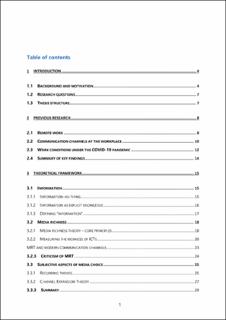| dc.description.abstract | This study explores information exchange and the usage of multiple communication channels at the workplace during the COVID-19 pandemic. The purpose is to gain an insight into factors that affected workers’ choice of communication channel when having the option to choose between multiple, often similar, communication software. Additionally, this study investigates what kind of information was exchanged in each channel. Data was collected by conducting semi-structured interviews with 10 workers who had mandatory home office during the pandemic. Media richness theory is used as a framework, as a way to “modernize” the theory, it is seen in the context of information communication channels which are frequently used at the workplace. As a way to investigate subjective aspects of media perception and choice, channel expansion theory is also applied. Differences between the ways in which workers perceive communication channels and communication software emerged. While the communication channels that were used at the office differed from one another, this was not the case with communication software, as many of them are similar in nature and have identical features. Findings indicate that workers preferred communication software often differs from the software that the organization intends for the workers to use. Three factors that affected workers’ channel choice were identified: Richness perception, organizational guidelines, and the COVID-19 pandemic. | en_US |
